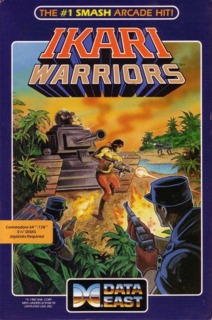Not as good as the arcade version, but "A, B, B, A" was aless expensive way to continue on to victory road.
You are either a red-garbed Rambo look-alike, or a blue-garbed Rambo look-alike (depending on whether or not you were playing two-player). Just like the premise of the later movie releases, your task is to cut a swath of destruction through countless henchmen to have a final showdown with one big, bad boss. Your machine gun never ran out of ammo, and your grenades could clear out a pocket of enemies whether they were entrenched in a pill box or clustered in the open.
Even though the graphics of the NES version pales in comparison to Tradewest's impressive arcade stand, they were still a solid offering of what early NES games were capable of. The flickering and teetering demise of countless enemies may have been tedious, but in 1987 we didn't know any different. The over-sized bullets were not meant to be taken seriously, but then neither was the source material from which the gameplay took its cues. Grenades seemingly careen up into the foreground of your view only to drop back down toward the ground before expelling their deadly payload. It was an animation trick never seen before in a top-down shooter.
As you fought your way through ruins, jungles, rivers, and bombed-out buildings you occasionally came across vehicles from which to deliver more punishing attacks against your foes. The tank allowed you to run over your foes and to shoot powerful shells to destroy gun emplacements and dispatch the afore-mentioned bottomless stream of cyan soldiers. The tank was just as slow, and cumbersome as your on-foot movements seemed, but was excellent at shielding you from enemy fire. Unfortunately your juggernaut came to an unfortunate end if an enemy grenade hit your tank, thus expelling your fleshy form back into harm’s way. The helicopter was quick, nimble, and just as full of fury as the tank. Though running over opponents was not as satisfying, the strafing and dodging were every bit as effective. If you were playing with a friend you could even both get your own vehicle if you got into the available vehicle at the same time! When both players were cruising around the levels with unstoppable force, the game was at its best.
The challenge of the game came not in enemy AI, but in sheer numbers. As a classic NES game, the measure of success was the score. Some power ups increased your score while others gave you modified firepower with which to shoot your way to victory. Picking up an S power-up gave you an immediate 200 points. F power-ups imbued your bullets with the power to shoot through rocks and walls, and to blow up tanks and bunkers. Impressive. The L ability increased your range, and the B ability increased the explosive power of your grenades. In the event you died after gaining any of the power-ups, you returned to your ordinary, stripped-down weapons. Grabbing a K power-up cleared the screen of all enemies, but only once.
What may seem to be an ordinary, and possibly mundane, form of gameplay combined with simple solutions to form an addictive and solid experience which allowed for hours of enjoyment, either by yourself or with a friend. When, not if, you die continuing the action was as easy as entering A, B, B, A on your gamepad. This was true of co-op as well as single-player experience. Unfortunately, in the final showdown with the boss, this trick no longer worked.
Despite the end being just as punishing, though less forgiving than the rest of the game, it made for an excellent, and exciting trip to victory road. . .

